Green Line (CTA)
The Green Line is a rapid transit line on the Chicago Transit Authority's "L" system. It is the only completely elevated route in the entire system; all other routes either have underground sections or sections at grade.[1] It utilizes the system's oldest segments (dating back to 1892), extending 20.695 miles (33.305 km) with 30 stops between Oak Park (Harlem/Lake) and Chicago's West Side, to the Loop, and then to the South Side and West Englewood (Ashland/63rd) and Woodlawn (Cottage Grove/63rd).
| Green Line | ||||||||||||||||||||||||||||||||||||||||||||||||||||||||||||||||||||||||||||||||||||||||||||||||||||||||||||||||||||||||||||||||||||||||||||||||||||||||||||||||||||||||||||||||||||||||||||||||||||||||||||||||||||||||||||||||||||||||||||||||||||||||||||||||||||||||||||||||||||||||||||||||||||||||||||||||||||||||||||||||||||||||||||||||||||||||||||||||||||||||||||||||||||||||||||||||||||||||||||||||||||||||||||||||||||||||||||||||||||||
|---|---|---|---|---|---|---|---|---|---|---|---|---|---|---|---|---|---|---|---|---|---|---|---|---|---|---|---|---|---|---|---|---|---|---|---|---|---|---|---|---|---|---|---|---|---|---|---|---|---|---|---|---|---|---|---|---|---|---|---|---|---|---|---|---|---|---|---|---|---|---|---|---|---|---|---|---|---|---|---|---|---|---|---|---|---|---|---|---|---|---|---|---|---|---|---|---|---|---|---|---|---|---|---|---|---|---|---|---|---|---|---|---|---|---|---|---|---|---|---|---|---|---|---|---|---|---|---|---|---|---|---|---|---|---|---|---|---|---|---|---|---|---|---|---|---|---|---|---|---|---|---|---|---|---|---|---|---|---|---|---|---|---|---|---|---|---|---|---|---|---|---|---|---|---|---|---|---|---|---|---|---|---|---|---|---|---|---|---|---|---|---|---|---|---|---|---|---|---|---|---|---|---|---|---|---|---|---|---|---|---|---|---|---|---|---|---|---|---|---|---|---|---|---|---|---|---|---|---|---|---|---|---|---|---|---|---|---|---|---|---|---|---|---|---|---|---|---|---|---|---|---|---|---|---|---|---|---|---|---|---|---|---|---|---|---|---|---|---|---|---|---|---|---|---|---|---|---|---|---|---|---|---|---|---|---|---|---|---|---|---|---|---|---|---|---|---|---|---|---|---|---|---|---|---|---|---|---|---|---|---|---|---|---|---|---|---|---|---|---|---|---|---|---|---|---|---|---|---|---|---|---|---|---|---|---|---|---|---|---|---|---|---|---|---|---|---|---|---|---|---|---|---|---|---|---|---|---|---|---|---|---|---|---|---|---|---|---|---|---|---|---|---|---|---|---|---|---|---|---|---|---|---|---|---|---|---|---|---|---|---|---|---|---|---|---|---|---|---|---|---|---|---|---|---|---|---|---|---|---|---|---|---|---|---|---|---|---|---|---|---|---|---|---|---|---|---|---|---|---|---|---|---|---|---|---|---|---|---|
 A Green Line train of 5000-series cars at 51st. | ||||||||||||||||||||||||||||||||||||||||||||||||||||||||||||||||||||||||||||||||||||||||||||||||||||||||||||||||||||||||||||||||||||||||||||||||||||||||||||||||||||||||||||||||||||||||||||||||||||||||||||||||||||||||||||||||||||||||||||||||||||||||||||||||||||||||||||||||||||||||||||||||||||||||||||||||||||||||||||||||||||||||||||||||||||||||||||||||||||||||||||||||||||||||||||||||||||||||||||||||||||||||||||||||||||||||||||||||||||||
| Overview | ||||||||||||||||||||||||||||||||||||||||||||||||||||||||||||||||||||||||||||||||||||||||||||||||||||||||||||||||||||||||||||||||||||||||||||||||||||||||||||||||||||||||||||||||||||||||||||||||||||||||||||||||||||||||||||||||||||||||||||||||||||||||||||||||||||||||||||||||||||||||||||||||||||||||||||||||||||||||||||||||||||||||||||||||||||||||||||||||||||||||||||||||||||||||||||||||||||||||||||||||||||||||||||||||||||||||||||||||||||||
| Type | Rapid transit | |||||||||||||||||||||||||||||||||||||||||||||||||||||||||||||||||||||||||||||||||||||||||||||||||||||||||||||||||||||||||||||||||||||||||||||||||||||||||||||||||||||||||||||||||||||||||||||||||||||||||||||||||||||||||||||||||||||||||||||||||||||||||||||||||||||||||||||||||||||||||||||||||||||||||||||||||||||||||||||||||||||||||||||||||||||||||||||||||||||||||||||||||||||||||||||||||||||||||||||||||||||||||||||||||||||||||||||||||||||
| System | Chicago "L" | |||||||||||||||||||||||||||||||||||||||||||||||||||||||||||||||||||||||||||||||||||||||||||||||||||||||||||||||||||||||||||||||||||||||||||||||||||||||||||||||||||||||||||||||||||||||||||||||||||||||||||||||||||||||||||||||||||||||||||||||||||||||||||||||||||||||||||||||||||||||||||||||||||||||||||||||||||||||||||||||||||||||||||||||||||||||||||||||||||||||||||||||||||||||||||||||||||||||||||||||||||||||||||||||||||||||||||||||||||||
| Status | Operational | |||||||||||||||||||||||||||||||||||||||||||||||||||||||||||||||||||||||||||||||||||||||||||||||||||||||||||||||||||||||||||||||||||||||||||||||||||||||||||||||||||||||||||||||||||||||||||||||||||||||||||||||||||||||||||||||||||||||||||||||||||||||||||||||||||||||||||||||||||||||||||||||||||||||||||||||||||||||||||||||||||||||||||||||||||||||||||||||||||||||||||||||||||||||||||||||||||||||||||||||||||||||||||||||||||||||||||||||||||||
| Locale | Chicago, Oak Park and Forest Park, Illinois, United States | |||||||||||||||||||||||||||||||||||||||||||||||||||||||||||||||||||||||||||||||||||||||||||||||||||||||||||||||||||||||||||||||||||||||||||||||||||||||||||||||||||||||||||||||||||||||||||||||||||||||||||||||||||||||||||||||||||||||||||||||||||||||||||||||||||||||||||||||||||||||||||||||||||||||||||||||||||||||||||||||||||||||||||||||||||||||||||||||||||||||||||||||||||||||||||||||||||||||||||||||||||||||||||||||||||||||||||||||||||||
| Termini | Harlem Ashland/63rd, Cottage Grove | |||||||||||||||||||||||||||||||||||||||||||||||||||||||||||||||||||||||||||||||||||||||||||||||||||||||||||||||||||||||||||||||||||||||||||||||||||||||||||||||||||||||||||||||||||||||||||||||||||||||||||||||||||||||||||||||||||||||||||||||||||||||||||||||||||||||||||||||||||||||||||||||||||||||||||||||||||||||||||||||||||||||||||||||||||||||||||||||||||||||||||||||||||||||||||||||||||||||||||||||||||||||||||||||||||||||||||||||||||||
| Stations | 30 | |||||||||||||||||||||||||||||||||||||||||||||||||||||||||||||||||||||||||||||||||||||||||||||||||||||||||||||||||||||||||||||||||||||||||||||||||||||||||||||||||||||||||||||||||||||||||||||||||||||||||||||||||||||||||||||||||||||||||||||||||||||||||||||||||||||||||||||||||||||||||||||||||||||||||||||||||||||||||||||||||||||||||||||||||||||||||||||||||||||||||||||||||||||||||||||||||||||||||||||||||||||||||||||||||||||||||||||||||||||
| Daily ridership | 70,554 (avg. weekday September 2012) | |||||||||||||||||||||||||||||||||||||||||||||||||||||||||||||||||||||||||||||||||||||||||||||||||||||||||||||||||||||||||||||||||||||||||||||||||||||||||||||||||||||||||||||||||||||||||||||||||||||||||||||||||||||||||||||||||||||||||||||||||||||||||||||||||||||||||||||||||||||||||||||||||||||||||||||||||||||||||||||||||||||||||||||||||||||||||||||||||||||||||||||||||||||||||||||||||||||||||||||||||||||||||||||||||||||||||||||||||||||
| Website | CTA Green Line | |||||||||||||||||||||||||||||||||||||||||||||||||||||||||||||||||||||||||||||||||||||||||||||||||||||||||||||||||||||||||||||||||||||||||||||||||||||||||||||||||||||||||||||||||||||||||||||||||||||||||||||||||||||||||||||||||||||||||||||||||||||||||||||||||||||||||||||||||||||||||||||||||||||||||||||||||||||||||||||||||||||||||||||||||||||||||||||||||||||||||||||||||||||||||||||||||||||||||||||||||||||||||||||||||||||||||||||||||||||
| Operation | ||||||||||||||||||||||||||||||||||||||||||||||||||||||||||||||||||||||||||||||||||||||||||||||||||||||||||||||||||||||||||||||||||||||||||||||||||||||||||||||||||||||||||||||||||||||||||||||||||||||||||||||||||||||||||||||||||||||||||||||||||||||||||||||||||||||||||||||||||||||||||||||||||||||||||||||||||||||||||||||||||||||||||||||||||||||||||||||||||||||||||||||||||||||||||||||||||||||||||||||||||||||||||||||||||||||||||||||||||||||
| Opened | February 21, 1993 (Current operation) | |||||||||||||||||||||||||||||||||||||||||||||||||||||||||||||||||||||||||||||||||||||||||||||||||||||||||||||||||||||||||||||||||||||||||||||||||||||||||||||||||||||||||||||||||||||||||||||||||||||||||||||||||||||||||||||||||||||||||||||||||||||||||||||||||||||||||||||||||||||||||||||||||||||||||||||||||||||||||||||||||||||||||||||||||||||||||||||||||||||||||||||||||||||||||||||||||||||||||||||||||||||||||||||||||||||||||||||||||||||
| Operator(s) | Chicago Transit Authority | |||||||||||||||||||||||||||||||||||||||||||||||||||||||||||||||||||||||||||||||||||||||||||||||||||||||||||||||||||||||||||||||||||||||||||||||||||||||||||||||||||||||||||||||||||||||||||||||||||||||||||||||||||||||||||||||||||||||||||||||||||||||||||||||||||||||||||||||||||||||||||||||||||||||||||||||||||||||||||||||||||||||||||||||||||||||||||||||||||||||||||||||||||||||||||||||||||||||||||||||||||||||||||||||||||||||||||||||||||||
| Character | Elevated | |||||||||||||||||||||||||||||||||||||||||||||||||||||||||||||||||||||||||||||||||||||||||||||||||||||||||||||||||||||||||||||||||||||||||||||||||||||||||||||||||||||||||||||||||||||||||||||||||||||||||||||||||||||||||||||||||||||||||||||||||||||||||||||||||||||||||||||||||||||||||||||||||||||||||||||||||||||||||||||||||||||||||||||||||||||||||||||||||||||||||||||||||||||||||||||||||||||||||||||||||||||||||||||||||||||||||||||||||||||
| Depot(s) | Ashland Yard, Harlem Yard | |||||||||||||||||||||||||||||||||||||||||||||||||||||||||||||||||||||||||||||||||||||||||||||||||||||||||||||||||||||||||||||||||||||||||||||||||||||||||||||||||||||||||||||||||||||||||||||||||||||||||||||||||||||||||||||||||||||||||||||||||||||||||||||||||||||||||||||||||||||||||||||||||||||||||||||||||||||||||||||||||||||||||||||||||||||||||||||||||||||||||||||||||||||||||||||||||||||||||||||||||||||||||||||||||||||||||||||||||||||
| Rolling stock | 5000-series | |||||||||||||||||||||||||||||||||||||||||||||||||||||||||||||||||||||||||||||||||||||||||||||||||||||||||||||||||||||||||||||||||||||||||||||||||||||||||||||||||||||||||||||||||||||||||||||||||||||||||||||||||||||||||||||||||||||||||||||||||||||||||||||||||||||||||||||||||||||||||||||||||||||||||||||||||||||||||||||||||||||||||||||||||||||||||||||||||||||||||||||||||||||||||||||||||||||||||||||||||||||||||||||||||||||||||||||||||||||
| Technical | ||||||||||||||||||||||||||||||||||||||||||||||||||||||||||||||||||||||||||||||||||||||||||||||||||||||||||||||||||||||||||||||||||||||||||||||||||||||||||||||||||||||||||||||||||||||||||||||||||||||||||||||||||||||||||||||||||||||||||||||||||||||||||||||||||||||||||||||||||||||||||||||||||||||||||||||||||||||||||||||||||||||||||||||||||||||||||||||||||||||||||||||||||||||||||||||||||||||||||||||||||||||||||||||||||||||||||||||||||||||
| Line length | 20.695 mi (33.305 km) | |||||||||||||||||||||||||||||||||||||||||||||||||||||||||||||||||||||||||||||||||||||||||||||||||||||||||||||||||||||||||||||||||||||||||||||||||||||||||||||||||||||||||||||||||||||||||||||||||||||||||||||||||||||||||||||||||||||||||||||||||||||||||||||||||||||||||||||||||||||||||||||||||||||||||||||||||||||||||||||||||||||||||||||||||||||||||||||||||||||||||||||||||||||||||||||||||||||||||||||||||||||||||||||||||||||||||||||||||||||
| Track gauge | 4 ft 8 1⁄2 in (1,435 mm) standard gauge | |||||||||||||||||||||||||||||||||||||||||||||||||||||||||||||||||||||||||||||||||||||||||||||||||||||||||||||||||||||||||||||||||||||||||||||||||||||||||||||||||||||||||||||||||||||||||||||||||||||||||||||||||||||||||||||||||||||||||||||||||||||||||||||||||||||||||||||||||||||||||||||||||||||||||||||||||||||||||||||||||||||||||||||||||||||||||||||||||||||||||||||||||||||||||||||||||||||||||||||||||||||||||||||||||||||||||||||||||||||
| Minimum radius | 90 feet (27 m) | |||||||||||||||||||||||||||||||||||||||||||||||||||||||||||||||||||||||||||||||||||||||||||||||||||||||||||||||||||||||||||||||||||||||||||||||||||||||||||||||||||||||||||||||||||||||||||||||||||||||||||||||||||||||||||||||||||||||||||||||||||||||||||||||||||||||||||||||||||||||||||||||||||||||||||||||||||||||||||||||||||||||||||||||||||||||||||||||||||||||||||||||||||||||||||||||||||||||||||||||||||||||||||||||||||||||||||||||||||||
| Electrification | Third rail, 600 V DC | |||||||||||||||||||||||||||||||||||||||||||||||||||||||||||||||||||||||||||||||||||||||||||||||||||||||||||||||||||||||||||||||||||||||||||||||||||||||||||||||||||||||||||||||||||||||||||||||||||||||||||||||||||||||||||||||||||||||||||||||||||||||||||||||||||||||||||||||||||||||||||||||||||||||||||||||||||||||||||||||||||||||||||||||||||||||||||||||||||||||||||||||||||||||||||||||||||||||||||||||||||||||||||||||||||||||||||||||||||||
| ||||||||||||||||||||||||||||||||||||||||||||||||||||||||||||||||||||||||||||||||||||||||||||||||||||||||||||||||||||||||||||||||||||||||||||||||||||||||||||||||||||||||||||||||||||||||||||||||||||||||||||||||||||||||||||||||||||||||||||||||||||||||||||||||||||||||||||||||||||||||||||||||||||||||||||||||||||||||||||||||||||||||||||||||||||||||||||||||||||||||||||||||||||||||||||||||||||||||||||||||||||||||||||||||||||||||||||||||||||||
Route
Lake Street Elevated

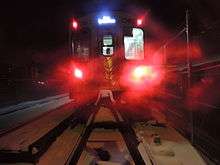
Beginning at the yard and inspection facilities in Forest Park, the Green Line runs east through Oak Park towards the city on an embankment adjacent to Metra's Union Pacific/West Line tracks from the Harlem Avenue terminal, on the border of Oak Park and Forest Park, to a point just west of Laramie Avenue. Here the Green Line tracks leave the railroad embankment and continue east on a steel elevated structure directly above Lake Street, a major east–west thoroughfare. The "L" bridges a couple of railroad tracks (The Belt Railway of Chicago's main line and UP's Rockwell Subdivision) before entering downtown Chicago at Clinton Street. East of Clinton Street, the route bridges Metra's Union Pacific railroad tracks (which terminate just south of here at Ogilvie Transportation Center) and the Chicago River before joining the Union Loop "L" tracks at Wells Street.
The Loop
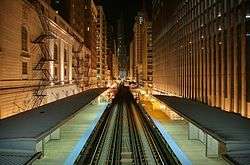
In downtown Chicago, the Green Line operates over the famous Union Loop "L" structure along with Brown Line (Ravenswood), Orange Line (Midway), Pink Line (Douglas) and Purple Line Express (weekday rush hours only) trains. However, Green Line trains operate both ways over the Lake Street and Wabash Avenue sides only, and does not use the Wells Street and Van Buren Street sides of the Loop.
The Green Line is the only line in the "L" system that has two entry/exit points to the elevated Loop, the only "L" line that runs in both directions on the Loop, and the only route that uses the Loop but does not terminate there. Its route uses the Wabash and Lake sides of the Loop, which are also used by the Orange, Pink, Purple and Brown Lines, which operate around the Loop and then return to their route terminal.
South Side Elevated
Leaving the Loop at Tower 12, the tracks continue along Wabash Avenue and follows an "S" curve (which was realigned in 2002) to the west and south now following the alley between Wabash Avenue and State Street to 40th Street. This 3.8 mile section is the oldest part of Chicago's "L" system. On this segment, the Green Line shares tracks with the Orange Line between the Loop and 17th Street. Passengers can transfer between the two lines at Roosevelt/Wabash station. The other stations on this section are at Cermak–McCormick Place and 35th–Bronzeville–IIT, adjacent the Illinois Institute of Technology campus and the Chicago Police Department Headquarters. At 40th Street, the route turns east to Indiana station, then turns south between Calumet and Prairie Avenues to the Garfield station and continues south to 59th Street where the route splits into two branches—the Englewood (Ashland/63rd) branch and the Jackson Park (East 63rd) branch. Prior to 1994 (and the Green Line's major renovation) the East 63rd branch extended as far east as Stony Island Avenue. It was shortened to University in 1982 and Cottage Grove in 1996.
Ashland branch
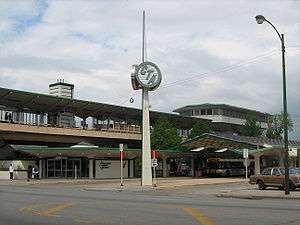
The Ashland branch continues south and west following 59th Street, Princeton Avenue and 63rd Street to the Ashland terminal in West Englewood. The yard and inspection shop lie to the south between the old Racine station and the Ashland/63rd terminal. The "L" tracks continues west to a stub end at Hermitage Avenue, a prediction for a future extension of the route westward, however, those plans were canceled in the late 1970s. Prior to 1992, the Englewood branch had two additional stops at Wentworth and Harvard, closed by the CTA for service cuts. Halsted/63rd is the only remaining stop on the 3.1 miles (5.0 km) route.
The Englewood branch was permanently renamed the Ashland branch as of March 2013 according to the CTA.
Jackson Park branch
The Jackson Park branch continues south from the mainline between Calumet and Prairie Avenues, passing the old yard and inspection facilities at 61st Street in Washington Park. South of here, the route curves east over 63rd Street and follows it to the current terminal at Cottage Grove/63rd in Woodlawn. Prior to 1994, the Jackson Park branch of the Green Line once terminated at University/63rd and before that, at Stony Island/63rd from 1893 until 1982. In addition to losing the University/63rd station, the Jackson Park branch also lost the 61st Street station and the 58th Street station in 1994.
Operating hours and headways
The Green Line operates weekdays from 4 a.m. to 1 a.m., and Saturdays and Sundays from 5 a.m. to 1 a.m. On the trunk of the Green Line between Harlem/Lake and Garfield, trains run on a minimum headway of 15 minutes, decreasing to as few as 7-8 minutes during weekday rush hours. Headways are doubled on the Ashland/63rd and Cottage Grove branches.[2]
Rolling stock
The Green Line is operated with the Bombardier-built 5000-series railcars. The 5000-series cars officially began running on the Green Line on July 1, 2012 after the Pink Line became fully equipped with the new cars. As additional 5000-series cars were assigned to the Green Line, the remaining 2400-series cars were reassigned to the Red, Purple and Orange Lines to finish their service lives. Occasionally, 2600-series and 3200-series railcars were used on the Green Line, though these were loaned from the Blue, Brown, and Orange Lines, and only when the Green Line was short on cars. With the 5000-series cars now completely equipping the Green Line fleet after the last of the 2400-series cars were reassigned in mid-May 2013, the borrowing of 2600-series cars and 3200-series cars is no longer necessary. The Green Line was the second line to be fully equipped with the 5000-series cars, following the Pink Line. Frequently, the Green and Pink Lines borrow each other's cars when either line is short on cars. Trains operate using six cars during weekday rush hours and four cars during other times on weekdays and all day on weekends.
History

The Green Line operates over the two oldest sections of the Chicago "L". The South Side section started operation in 1892 when Chicago was preparing for the World's Columbian Exposition of 1893 in Jackson Park. The initial section was built to provide inexpensive mass transportation service between downtown Chicago and the exposition site. This first section of the Chicago and South Side Rapid Transit Railroad between Wabash Avenue and State Street went into service on June 6, 1892.[3] It extended from Congress Street only as far south as 39th Street (Pershing Road). At that time a large part of the south side was little more than prairie, but by May 1, 1893, when the pioneer "L" line was completed to Jackson Park, construction of homes, apartment buildings and commercial properties was booming in the area.
Continued expansion of the area development was reflected in construction of the Englewood, Normal Park, Kenwood and Stock Yards branches of the South Side "L" between 1905 and 1908. Of these, only the Englewood and Jackson Park branches remain: because of insufficient patronage, the Normal Park, Stock Yards and Kenwood branches were closed in the 1950s.



The Lake Street Elevated was Chicago's second rapid transit line. It began operation from a terminal at Madison and Market streets to Lake Street and California Avenue on November 6, 1893.[4] The line was gradually extended westward to Laramie Avenue on April 29, 1894; to Austin Avenue on April 15, 1899;[5] to Wisconsin Avenue, Oak Park using street railway trackage on May 15, 1899 (closed in 1902), and to Marengo Avenue, Forest Park, on May 14, 1910.
The construction of the Lake Street Elevated led to a political quarrel in west suburban Cicero, which at the time included Oak Park and Austin. In 1898, Austinites, having a majority on Cicero's town council, used political influence to allow the extension of the Lake Street line from the city border at Laramie Avenue (then called 52nd Avenue) into their community. This infuriated other Cicero residents, who retaliated the following year by holding a joint election to force Austin's annexation to the City of Chicago. Much to the dismay of local residents, this effort succeeded, and Austin became part of Chicago in 1899. A century later, Oak Park commuters, who had come to depend on the service, were among the most vocal critics of the Green Line's closure for rehabilitation.
From 1913 until 1993, the Englewood and Jackson Park branches were part of the North–South Route in various service configurations operating from the north side through the Loop and to the south side. On October 17, 1943, the Englewood and Jackson Park services were rerouted into the State Street subway to provide improved crosstown access through the heart of city and to alleviate congestion on the over-crowded Union Loop Elevated. On July 31, 1949, during the north–south rapid transit service revision by the CTA, the Howard–Englewood/Jackson Park route was created, operating via the State Street subway, using the 13th Street portal.
On May 6, 1969, the Englewood branch was extended to the current Ashland Avenue-West Englewood Terminal, replacing the outmoded facilities at the 1907-built Loomis station which were demolished. On December 12, 1982, the Jackson Park branch was shortened to University because of structural deterioration at the Dorchester Bridge which carried the route across the Illinois Central Railroad to the former Stony Island/63rd terminal which closed on March 4, 1982 and was later demolished.
The Lake Street "L" would remain largely unchanged until 1948, when a number of its historic passenger stations were closed and demolished in an attempt to promote the "A" and "B" skip-stop express train service to speed up traffic flow. On October 28, 1962, the western two and one-half mile section of the line which operated at street level was elevated along the Chicago and Northwestern Railroad right-of-way opening new elevated stops at Central, Austin, Ridgeland, Oak Park, and Harlem. On September 28, 1969, the Lake Street "L" was united with the new Dan Ryan Line to form the West–South Route (Lake-Dan Ryan), operating from Forest Park through downtown via the Union Loop "L" to 95th/Dan Ryan. The Lake–Dan Ryan routing was to fulfill the service implementation outlined in the 1968 Chicago Central Area Transit Plan. However, when that controversial subway project was cancelled in 1979, Lake–Dan Ryan service remained and lasted for 24 years.
On February 21, 1993, the South Side sections of the North–South and West–South Routes were "switched" south of Roosevelt Road, creating the current Red Line (Howard–Dan Ryan) and the Green Line (Lake–Englewood/Jackson Park). After the reconfiguration, both the Red and Green Lines lost their "A" and "B" skip-stop service and began serving all stations at all times. As stated earlier, the Green Line's routing united the two oldest segments of Chicago's "L"-Subway rail network.
On January 9, 1994, the Green Line closed for the largest transit rehabilitation project in the city's history. The Green Line reopened on May 12, 1996, with much of the renewal work completed and with the exception of a few stations. Six stations (Homan, Halsted, 58th, 61st, University, and Racine) were closed permanently following the rehabilitation project, which angered many commuters who depend on the Green Line. On September 27, 1997, after political pressure brought on by community leaders, the Jackson Park branch was shortened again from University to Cottage Grove after previous attempts by the City, CTA, and other agencies to extend the route eastward to Dorchester, immediately west of the Illinois Central Railroad. This had seemed logical to the Dorchester Terminal, due to the fact that the Metra Electric District and South Shore Line both share a station along the IC ROW, at 63rd Street.
On April 26, 1998, the Green Line, like the Purple Line and the Douglas branch of the Blue Line (now the Pink Line) lost its 24-hour service due to budget cuts and operates only between the hours of 4 a.m. and 1 a.m weekdays.
Incidents
On February 4, 1977, an accident occurred on the sharp left-hand curve at Wabash/Lake. Two trains were involved, one was the Ravenswood Line with the second being the Lake-Dan Ryan Line. The Ravenswood train was stopped waiting for the clearance to proceed. The motorman of the Lake-Dan Ryan train failed to see the signals warning him of a stopped train. What occurred was a rear-end collision, the initial collision was only minor. However the motorman continued to apply power forward; which led to three cars being pushed off the elevated tracks to the street below. The fourth car was dangling while still attached to the other four cars on the track. 11 deaths were reported with more than 180 injuries.[6]
On May 28, 2008, a derailment was reported, with approximately 24 injuries. Two train cars on the four-car train appeared to be derailed, with the leading car abutting the one behind it at an angle of approximately 150 degrees. The train cars were separated at a switching point near 59th Street.[7]
On August 5, 2015, a derailment was reported near 63rd and Calumet in Chicago's Washington Park neighborhood. The train derailed around 2:40 p.m., the third of the four-car train was the one to derail. No one was injured, firefighters had to help over 80 passengers off the train; two of which were in wheelchairs. Service was suspended between the Cottage Grove and Garfield stops. Service was back to normal in the affected stops around 7:15 p.m.[8]
On June 6, 2019, a Green Line train derailed near the 47th station, injuring 7 people.[9][10]
Green Line expansion
During the 2010s, the Green Line has undergone significant expansion in an attempt to attract more transit riders and improve upon its service connectivity on the West Side, Loop, and South Side communities. The Morgan/Lake station opened on May 18, 2012 in response to the growing Fulton Market and West Loop areas. It was followed by the opening of the new Cermak–McCormick Place station on February 8, 2015, serving the historic Motor Row District and McCormick Place Convention Center. Both stations were designed by Chicago-based Ross Barney Architects. The Garfield station's $43 million reconstruction project, completed in January 2019, restored its original 1892-built station house and improved the in-service station house; it included escalator and elevator enhancements and new platform canopies, lights, graphics, public artwork, and streetscape. The project also created a new "Garfield Gateway" station in the Washington Park neighborhood on the South Side. A new station is being constructed on the Lake Street "L" at Damen/Lake, replacing a former station at that site from 1893 to 1948. Designed by world-renown architectural firm Perkins + Will (who also designed the Cumberland station on the O'Hare Extension in 1980), the new $60 million Damen station will fill the 1.5-mile distance between the California and Ashland stations, scheduled to open in 2021.
Along the Green Line South, the former 58th Street station, which was located approximately 3/8 mile south of the Garfield station and one-block north of the Englewood and Jackson Park branches, had been bereft of a transfer facility between the diverging Green Line services since 1994. The branch lines themselves consists of only two stations (Halsted and Ashland/63rd on the Englewood branch; King Drive and Cottage Grove on the Jackson Park Branch). While no official plans have been developed to built future stations on the Green Line South, the possibility of a new Stony Island/63rd terminal station to serve Hyde Park, South Shore, the Museum of Science & Industry, and the proposed Barack Obama Presidential Center would be very advantageous. A major benefit would be the resurgence of passenger and traffic volumes on the Englewood and Jackson Park branches to those prior to 1982, with more modern, attractive, and convenient transit service on the South Side "L," thus supplementing, and not competing with the Dan Ryan branch of the Red Line.
Points of interest
The Green Line provides access to other destinations, the Garfield Park Conservatory (Conservatory–Central Park Drive), United Center (Ashland) James R. Thompson Center, Richard J. Daley Center and City Hall–Cook County Building (Clark/Lake), Millennium Park (Washington/Wabash), the Art Institute of Chicago (Adams/Wabash), the Auditorium Building of Roosevelt University, Museum Campus and Soldier Field (Roosevelt/Wabash), the Illinois Institute of Technology and Guaranteed Rate Field (White Sox Park) (35th–Bronzeville–IIT), the University of Chicago (Garfield) and Kennedy–King College (Halsted/63rd). The Clinton/Lake and Washington/Wabash stops are useful for reaching Metra and South Shore Line trains at the Ogilvie Transportation Center and Millennium Station.
Station listing
| Location | Station | Points of interest and notes |
|---|---|---|
| Oak Park / Forest Park | Harlem/Lake |
Points of interest: Downtown Oak Park, transfer to Oak Park (Metra), Forest Preserve District of Cook County Headquarters |
| Oak Park | Oak Park | Points of interest: Frank Lloyd Wright Home and Studio, Unity Temple, Ernest Hemingway Museum & Birthplace, Oak Park Public Library |
| Ridgeland | Points of interest: Oak Park and River Forest High School | |
| Austin, Chicago | Austin | Connections:
|
| Central |
Points of interest: Columbus Park, Walser House, and Austin Town Hall | |
| Laramie |
Connections:
| |
| Cicero |
Points of interest: Former Brach's Candy Factory | |
| West Garfield Park, Chicago | Pulaski |
Points of interest: Chicago Public Library Legler branch |
| East Garfield Park, Chicago | Conservatory–Central Park Drive |
Points of interest: Garfield Park Conservatory, Garfield Park Field house |
| Homan | Closed January 9, 1994; structure reused for Conservatory–Central Park Drive | |
| Kedzie |
Connections:
| |
| California |
Points of interest: Chicago Center for Green Technology | |
| Near West Side, Chicago | Damen |
Reopening in 2021[11][12] |
| Ashland |
Points of interest: United Center (Home of the Chicago Bulls and the Chicago Blackhawks), Union Park | |
| Morgan |
Points of interest: UIC, Greektown, Coyne College, Fulton Market District | |
| Halsted | Closed January 9, 1994 | |
| Clinton |
Points of interest: Chicago Transit Authority Headquarters | |
| The Loop, Chicago | Clark/Lake |
Points of interest: James R. Thompson Center and Richard J. Daley Center |
| State/Lake | Points of interest: Chicago Theatre, Gene Siskel Film Center, Harold Washington College | |
| Closed September 3, 2017; demolished and replaced by Washington/Wabash | ||
| Washington/Wabash |
Consolidation of Madison/Wabash and Randolph/Wabash. Opened August 31, 2017
Points of interest: | |
| Madison/Wabash | Closed March 16, 2015; demolished and replaced by Washington/Wabash | |
| Adams/Wabash | Points of interest: Grant Park, Petrillo Music Shell, Buckingham Fountain, Art Institute of Chicago, Orchestra Hall, and DePaul University | |
| The Loop, Chicago / Near South Side, Chicago | Roosevelt |
Points of interest: Field Museum of Natural History, Soldier Field, Shedd Aquarium, and Adler Planetarium |
| Near South Side, Chicago | Cermak–McCormick Place |
Points of interest: McCormick Place, Wintrust Arena, and Motor Row District |
| Douglas, Chicago | 35th–Bronzeville–IIT |
Points of interest: Illinois Institute of Technology, Shimer College, De La Salle Institute, Chicago Police Headquarters, Douglas Tomb State Memorial, Pilgrim Baptist Church, Victory Sculpture, Chicago Defender Building, Eighth Regiment Armory, Guaranteed Rate Field, Black Metropolis-Bronzeville District, and Bronzeville |
| Grand Boulevard, Chicago | Indiana |
Former terminal for Stock Yards and Kenwood Lines Points of interest: |
| 43rd |
Points of interest: North Kenwood District, and King College Prep High School | |
| 47th |
Points of interest: Harold Washington Cultural Center, and Robert S. Abbott House | |
| Grand Boulevard, Chicago and Washington Park, Chicago | 51st |
Points of interest: Provident Hospital of Cook County, KAM Isaiah Israel, Kenwood Academy, and Barack Obama House |
| Washington Park, Chicago | Garfield |
Transfer between Ashland/63rd and Cottage Grove bound trains Points of interest: |
| 58th | Closed January 9, 1994 | |
| Englewood, Chicago | Halsted |
Englewood branch Points of interest: |
| Englewood, Chicago / West Englewood, Chicago | Racine | Englewood branch, closed January 9, 1994 |
| West Englewood, Chicago | Ashland/63rd |
Englewood branch Points of interest: |
| Washington Park, Chicago | 61st | Jackson Park branch, Closed January 9, 1994 |
| Washington Park, Chicago / Woodlawn, Chicago / Greater Grand Crossing, Chicago | King Drive |
Jackson Park branch, inbound boarding only Points of interest: |
| Woodlawn, Chicago | Cottage Grove |
Jackson Park branch Points of interest: |
| University | Jackson Park branch, closed January 9, 1994 |
References
- World.nycsubway.org – Chicago Green Line
- "Green Line Trains schedule" (PDF). Chicago Transit Authority. transitchicago.com. Retrieved June 3, 2018.
- "Running on the "L."". Chicago Daily Tribune. June 7, 1892. p. 9.
- "Crowds on Lake Street "L."". Chicago Daily Tribune. November 7, 1893. p. 8.
- "Austin Hails Five-Cent Fares". Chicago Daily Tribune. April 15, 1899. p. 5.
- Krambles, George; Peterson, Arthur H. (1993). CTA at 45. Oak Park, IL, U.S.A: Published for the George Krambles Transit Scholarship Foundation. p. 116. ISBN 9780963796547.
- https://www.ntsb.gov/investigations/AccidentReports/Reports/RAB1102.pdf
- "CTA Green Line train derails at 63rd, Calumet". ABC7 Chicago. Retrieved 2015-08-05.
- https://chicago.suntimes.com/2019/6/6/18655395/green-line-train-derails-bronzeville-47th
- https://www.nbcchicago.com/news/local/green-line-cta-chicago-transit-authority-510917481.html
- https://www.transitchicago.com/mayor-emanuel-joins-alderman-burnett-cdot-cta-and-dcase-at-groundbreaking-for-new-cta-green-line-station-at-damen--lake/
- https://chicago.curbed.com/2018/7/9/17548886/construction-green-line-damen-stop-perkins-will
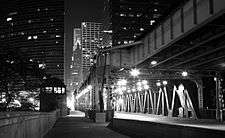
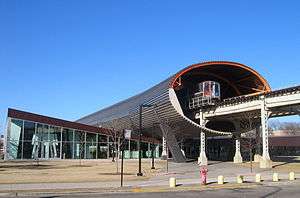
.jpg)